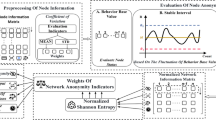Abstract
Problems of secure communications on the Internet and anonymous access to network resources are considered. A problem is revealed, which involves an increase in the probability of deanonymization of TOR network users when using the servers under common administrative control in one chain. An approach to recognition of “hidden groups” of servers of TOR anonymization network through analysis of the server characteristics frequency and their clustering based on similarity is suggested. These studies demonstrate the approaches to improve software of the TOR anonymization network and increase user security.






Similar content being viewed by others
REFERENCES
OrNetRadar. https://nusenu.github.io/OrNetRadar. Cited May 15, 2020.
Specification of Tor protocol: Official website. https://gitweb.torproject.org/torspec.git. Cited May 15, 2020.
Chakravarty, S., Traffic analysis attacks and defenses in low latency anonymous communications, PhD Thesis, New York: Columbia University, 2014.
Dingledine, R., Mathewson, N., and Syverson, P., Tor: The second-generation onion router, Onion Router. http://www.onion-router.net/Publications/tor-desingn.pdf. Cited May 15, 2020.
Collection of characteristics of nodes of Tor network. http://collector.torproject.org. Cited May, 2020.
Eremeev, M.A., Nefedov, V.S., Ostrovsky, A.S., and Semchenkov, D.A., Approach to detect DNS-based covert channels by identifying beacon signals, Probl. Inf. Bezop. Komp’yut. Sist., 2020, no. 3, pp. 40–49.
Latypov, I.T. and Eremeev, M.A., Multilevel model of computer attack based on attributive metagraphs, Autom. Control Comput. Sci., 2020, vol. 54, no. 8, pp. 944–948. https://doi.org/10.3103/S0146411620080192
Zegzhda, D., Zegzhda, P., Pechenkin, A., and Poltavtseva, M., Modeling of information systems to their security evaluation, Proc. 10th Int. Conf. on Security of Information and Networks, Jaipur, India, 2017, New York: Association for Computing Machinery, 2017, pp. 295–298. https://doi.org/10.1145/3136825.3136857
Author information
Authors and Affiliations
Corresponding authors
Ethics declarations
The authors declare that they have no conflicts of interest.
Additional information
Translated by A. Muravev
About this article
Cite this article
Nefedov, V.S., Kriulin, A.A. & Eremeev, M.A. Approach to Recognition of Malicious Servers of TOR Anonymization Network Based on Cluster Analysis. Aut. Control Comp. Sci. 55, 1209–1214 (2021). https://doi.org/10.3103/S0146411621080411
Received:
Revised:
Accepted:
Published:
Issue Date:
DOI: https://doi.org/10.3103/S0146411621080411




